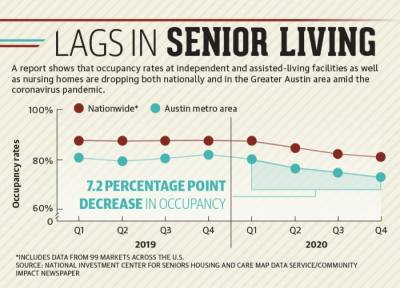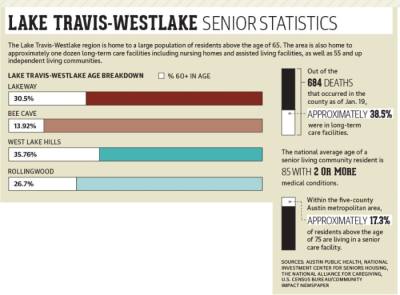When Greg Morper moved his 92-year-old mother from independent living to a memory care unit at Arbor Terrace Lakeway, he said he hoped it would aid in the treatment of her dementia by ensuring she had interactions every day.
Evolving restrictions to prevent the spread of the COVID-19 virus have included visiting his mother, Ernestine, from the outside through a bedroom window, to later sitting with her outdoors 6 feet apart. In January, Ernestine tested positive for COVID-19, and though she remained asymptomatic, she was required to enter quarantine.
Overall, Morper said he is grateful for the necessary precautions taken by the facility, but the experience has been challenging.
“One of the hardest things [is] when you’re thinking about the person you love and you’re thinking who knows how long she’s going to live, period,” Terry Morper, Greg’s wife said. “To think that the last however many months of her life have been without us there, and the whole reason we moved her here was to be with her.”
Greg Morper said if they knew last year how substantial the health crisis would become, he likely would have considered alternative care for his mother, such as in-home aide.
The decision to relocate out of an assisted living or nursing home community or to delay moving into a facility is one that many seniors and their families have made this year.
Experiences like the Morpers’ are fueling immediate changes to the senior care industry, forcing national and local operators to confront rising expenses while dealing with unprecedentedly low occupancy rates. But industry officials say the changes are not likely to be long-lasting because of the underlying need for senior care.
“We’ve got the wind in our sails with respect to the demography because we are about to have a whole lot more seniors than we’ve seen before,” Patricia Will, CEO of Belmont Village, which operates communities in Lakeway and West Lake Hills.
In 2020, occupancy rates for senior living centers nationwide and in the Austin metropolitan area declined, according to a report from the National Investment Center for Seniors Housing and Care, or NIC, a research group. Austin’s rate was reported at 72.9% in the fourth quarter of 2020, which is lower than both the national average and historic trends.
The Greater Austin area’s senior living occupancy rates are the third lowest in the nation, according to Beth Mace, NIC’s chief economist and director of outreach. This is in part due to the plethora of options available. The Lake Travis-Westlake region, in particular, is home to an abundance of senior living providers, including more than a dozen assisted-living communities and another facility under construction.
And while many seniors moved out of their communities as a result of the pandemic, the drop in occupancy was also the result of facilities across the nation closing their doors to new residents, Mace said.
Local senior communities, including Belmont Village, temporarily halted new resident admissions in an effort to pivot operations and control the pandemic’s initial impact.
Will said this was the right decision for the company and its residents—still, it affected revenue.
“No one in my industry, much less me, could sit here with a straight face and not tell you that revenues were down,” she said.
Furthermore, the significant operational changes required to manage the health crisis led to increased expenses. Will said those costs include additional staff, personal protective equipment and the particularly high cost of frequent COVID-19 testing.
In an April letter to the Department of Health and Human Services, the American Seniors Housing Association stated the cost of maintaining quality care in senior communities could increase more than 73% in 2020. Months later in December, the ASHA reported the need for additional federal relief to overset the costs.
That projection is not on par with what Belmont Village experienced, according to Will, and though expenses have increased, she said the 24-year-old company has the ability to weather the storm.
Will said she does not anticipate an immediate financial recovery, yet she said senior living facilities will continue to serve as a much-needed resource post-pandemic—especially as the population of individuals over the age of 65 rapidly increases.
Other senior living professionals have shared a similar sentiment. The pandemic has not made the need for senior living communities obsolete, but it may alter what seniors and their families look for in a home, according to Will.
Impacts on the industry
Lakeway resident Jay Hufford has worked in the senior care industry for more than 15 years. He is the founder of A Better Place, a company that advises seniors on available living options.
In his experience, local facilities are reporting some of their lowest occupancy numbers to date, according to Hufford, who said he witnessed the pandemic’s immediate impact on the industry.
Hesitations surrounding a potential coronavirus outbreak or the fear of long-term isolation strayed families away from senior living homes.
“The people that normally would have gone into [a senior home] instead got in-home caregivers,” Hufford said, adding in-home service saw a large influx in business this year.
Yet many families have discovered in-home care to be what Hufford called a “temporary Band-Aid.”
Home care is not always an adequate option for those who may need round-the-clock assistance, Hufford said, adding that it can also be a costly choice, especially for those who need frequent care. The stress of caring for a loved one at home can be exacerbated when families attempt to take on care themselves.
Because of these challenges, there could be a pent-up demand for senior living centers as the pandemic progresses. Will said Belmont Village has already seen a glimpse of this resurgence.
“We have residents who hesitated to move into independent living that are now tired of being in their apartments by themselves. They’re worried about what happens if [they] fall during the night,” Will said.
Many find senior living communities an attractive housing option because of the lack of isolation, Will said. Clint Strickland, Belmont Village Lakeway’s executive director, said the COVID-19-era isolation will have long-standing repercussions for seniors.
“I can’t overstate the detrimental impact of isolation. We’ve seen a small piece of it in our own communities when we had to isolate, but now we’re starting to see the negative impacts that it had on people as they’re coming to us,” Strickland said.
As COVID-19 testing and data became more widely available, Belmont Village communities were able to continue activities such as yoga and art classes—amenities that initially attracted residents to the communities.
Will said seniors orient toward two components when searching for living options—hospitality and health care. In light of the pandemic, she believes seniors and their families will put an emphasis on the health care component of senior living. Health care procedures, on-site trained nurses and technological capabilities will be on the forefront of potential residents’ minds.
“I think that this is a sustained crisis that is going to cause consumer tastes and preferences to change. We’ve seen that in a lot of other sectors, and I don’t think we’re going to be any different,” Will said.
Hufford agreed and said when selecting a community, seniors have put an emphasis on personal care and attention over the facilities’ amenities and real estate.
Those changes could bring about a silver lining, according to Will. For example, the use of telemedicine has been beneficial for seniors when emergency room visits have been unnecessary and undesirable. Overall, the heightened use of technology has been a “game-changer” for the industry, Will said.
The pandemic may create another shift within the senior care industry. Hufford said there has been an increase in small assisted-living centers, often called personal care homes, which typically hold up to 16 beds. While the Lake Travis-Westlake region is not home to this community style, Hufford said the smaller population may be appealing for seniors.
Despite the ongoing efforts to adapt, senior living communities will continue to face immense challenges as the pandemic progresses. However, as the early stages of vaccine rollouts continue throughout Texas, seniors and industry leaders have seen a light at the end of the tunnel.
“I haven’t found that senior living is less relevant, and I think it’s kind of revealing to people that senior living isn’t about survival, it’s about living the right way for an important phase of your life,” Hufford said.









